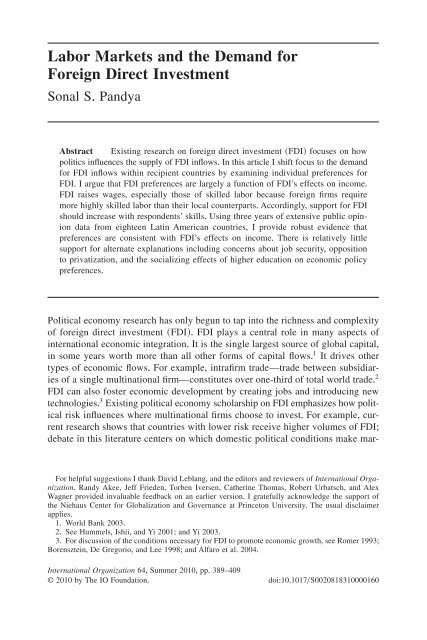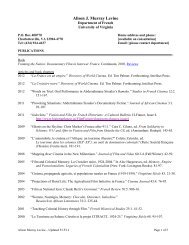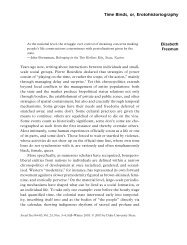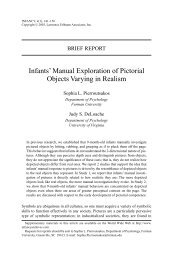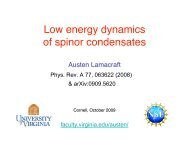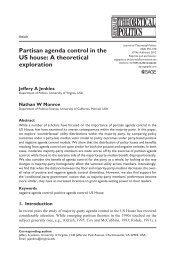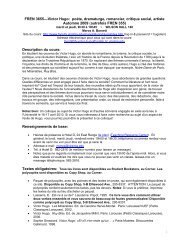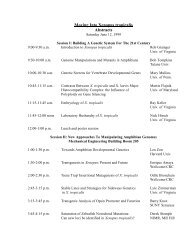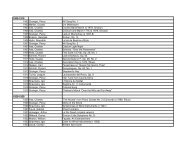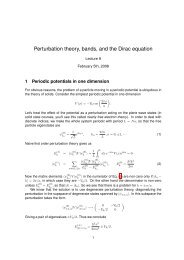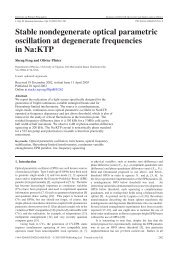Labor Markets and the Demand for Foreign Direct Investment
Labor Markets and the Demand for Foreign Direct Investment
Labor Markets and the Demand for Foreign Direct Investment
Create successful ePaper yourself
Turn your PDF publications into a flip-book with our unique Google optimized e-Paper software.
<strong>Labor</strong> <strong>Markets</strong> <strong>and</strong> <strong>the</strong> Dem<strong>and</strong> <strong>for</strong><br />
<strong>Foreign</strong> <strong>Direct</strong> <strong>Investment</strong><br />
Sonal S+ P<strong>and</strong>ya<br />
Abstract Existing research on <strong>for</strong>eign direct investment ~FDI! focuses on how<br />
politics influences <strong>the</strong> supply of FDI inflows+ In this article I shift focus to <strong>the</strong> dem<strong>and</strong><br />
<strong>for</strong> FDI inflows within recipient countries by examining individual preferences <strong>for</strong><br />
FDI+ IarguethatFDIpreferencesarelargelyafunctionofFDI’seffectsonincome+<br />
FDI raises wages, especially those of skilled labor because <strong>for</strong>eign firms require<br />
more highly skilled labor than <strong>the</strong>ir local counterparts+ Accordingly, support <strong>for</strong> FDI<br />
should increase with respondents’ skills+ Using three years of extensive public opinion<br />
data from eighteen Latin American countries, Iproviderobustevidencethat<br />
preferences are consistent with FDI’s effects on income+ There is relatively little<br />
support <strong>for</strong> alternate explanations including concerns about job security, opposition<br />
to privatization, <strong>and</strong> <strong>the</strong> socializing effects of higher education on economic policy<br />
preferences+<br />
Political economy research has only begun to tap into <strong>the</strong> richness <strong>and</strong> complexity<br />
of <strong>for</strong>eign direct investment ~FDI!+ FDI plays a central role in many aspects of<br />
international economic integration+ It is <strong>the</strong> single largest source of global capital,<br />
in some years worth more than all o<strong>the</strong>r <strong>for</strong>ms of capital flows+ 1 It drives o<strong>the</strong>r<br />
types of economic flows+ For example, intrafirm trade—trade between subsidiaries<br />
of a single multinational firm—constitutes over one-third of total world trade+ 2<br />
FDI can also foster economic development by creating jobs <strong>and</strong> introducing new<br />
technologies+ 3 Existing political economy scholarship on FDI emphasizes how political<br />
risk influences where multinational firms choose to invest+ For example, current<br />
research shows that countries with lower risk receive higher volumes of FDI;<br />
debate in this literature centers on which domestic political conditions make mar-<br />
For helpful suggestions I thank David Leblang, <strong>and</strong> <strong>the</strong> editors <strong>and</strong> reviewers of International Organization+<br />
R<strong>and</strong>y Akee, Jeff Frieden, Torben Iversen, Ca<strong>the</strong>rine Thomas, Robert Urbatsch, <strong>and</strong> Alex<br />
Wagner provided invaluable feedback on an earlier version+ Igratefullyacknowledge<strong>the</strong>supportof<br />
<strong>the</strong> Niehaus Center <strong>for</strong> Globalization <strong>and</strong> Governance at Princeton University+ The usual disclaimer<br />
applies+<br />
1+ World Bank 2003+<br />
2+ See Hummels, Ishii, <strong>and</strong> Yi 2001; <strong>and</strong> Yi 2003+<br />
3+ For discussion of <strong>the</strong> conditions necessary <strong>for</strong> FDI to promote economic growth, see Romer 1993;<br />
Borensztein, De Gregorio, <strong>and</strong> Lee 1998; <strong>and</strong> Alfaro et al+ 2004+<br />
International Organization 64, Summer 2010, pp+ 389–409<br />
©2010byTheIOFoundation+ doi:10+10170S0020818310000160
390 International Organization<br />
kets appealing to <strong>for</strong>eign investors+ 4 These studies model <strong>the</strong> choices of multinational<br />
firms to provide political economy explanations <strong>for</strong> <strong>the</strong> supply of FDI<br />
inflows+ Although this is an important topic, it is only one dimension of FDI’s<br />
politics+<br />
In this article I focus on <strong>the</strong> dem<strong>and</strong> <strong>for</strong> FDI+ Specifically, Idevelop<strong>and</strong>testa<br />
<strong>the</strong>ory of individual preferences <strong>for</strong> FDI inflows, arguing that preferences are a<br />
function of FDI’s distributional effects+ In FDI, multinational firms establish <strong>for</strong>eign<br />
subsidiaries to produce goods <strong>and</strong> services abroad+ These activities redistribute<br />
income within recipient countries by driving up labor dem<strong>and</strong>+ FDI increases<br />
<strong>the</strong> supply of productive capital+ <strong>Foreign</strong> firms create additional labor dem<strong>and</strong> by<br />
hiring local labor; consequently wages rise+ Skilled labor wages, in particular, rise<br />
because multinational firms are typically more technologically advanced <strong>and</strong> require<br />
more skilled labor than equivalent local firms+ Given <strong>the</strong>se distributional effects<br />
of FDI inflows, Ihypo<strong>the</strong>sizethatlaborsupportsFDIinflows<strong>and</strong>thatthissupport<br />
is greater among individuals at higher skill levels+<br />
Itest<strong>the</strong>seclaimswiththreeyearsofdatafrom<strong>the</strong>Latinobarometer, apublic<br />
opinion survey covering eighteen Latin American countries <strong>and</strong> perhaps <strong>the</strong> only<br />
major, multicountry survey project that inquires about attitudes toward FDI+ These<br />
data allow me to test <strong>the</strong> observable implications of FDI’s distributional effects<br />
<strong>for</strong> individuals’ preferences+ IshowthatFDIpreferencesareindeedconsistentwith<br />
FDI’s expected effect on individual income+ Specifically, support <strong>for</strong> FDI inflows<br />
increases with respondents’ skill level+ Respondents with a university education<br />
are between 7 to 10 percentage points more likely to support FDI inflows than<br />
respondents with less than a secondary school education+ This finding is robust to<br />
avarietyofalternateexplanationsincluding<strong>the</strong>socializing<strong>and</strong>in<strong>for</strong>mationaleffects<br />
of education, job insecurity, <strong>and</strong> opposition to privatization+<br />
By opening up a new dimension to FDI research, <strong>the</strong>se findings make two<br />
broader scholarly contributions+ First, <strong>the</strong>y build <strong>the</strong> foundation <strong>for</strong> a broader <strong>the</strong>ory<br />
of FDI dem<strong>and</strong>+ Preferences underlie more aggregate phenomena including lobbying<br />
<strong>for</strong> FDI policies, <strong>the</strong> existence <strong>and</strong> <strong>for</strong>m of national FDI regulation, <strong>and</strong><br />
choices about international cooperation on investment+ These are all aspects of<br />
FDI’s political economy about which little is known, even though <strong>the</strong>se are central<br />
questions in <strong>the</strong> study of o<strong>the</strong>r types of international economic flows+ 5 Awareness<br />
of <strong>the</strong> dem<strong>and</strong> side of FDI’s politics may prompt a reassessment of extant<br />
findings on FDI supply; <strong>the</strong> volume of FDI inflows may have as much to do with<br />
dem<strong>and</strong> <strong>for</strong> FDI as with investors’ willingness to supply investment+ 6 More generally,<br />
existing accounts of <strong>the</strong> political economy of international economic inte-<br />
4+ See Henisz 2002; Jensen 2003; <strong>and</strong> Li <strong>and</strong> Resnick 2003+ An earlier generation of research, strongly<br />
influenced by dependency <strong>the</strong>ory, argued that variation in FDI inflows is due to <strong>the</strong> ease with which<br />
governments can expropriate investments+ See Vernon 1971; <strong>and</strong> Kobrin 1987+<br />
5+ Studies of American FDI regulation by Kang 1997 <strong>and</strong> Crystal 2003 are notable exceptions+<br />
6+ Pinto <strong>and</strong> Pinto 2008 incorporate this insight in <strong>the</strong>ir claim that partisan preferences <strong>for</strong> FDI can<br />
influence investors’ perceptions of risk <strong>and</strong> <strong>the</strong>reby <strong>the</strong> volume of inflows+
<strong>Labor</strong> <strong>Markets</strong> <strong>and</strong> Dem<strong>and</strong> <strong>for</strong> <strong>Foreign</strong> <strong>Direct</strong> <strong>Investment</strong> 391<br />
gration are, at best, incomplete without greater attention to <strong>the</strong> politics of FDI<br />
support+<br />
Second, <strong>the</strong>se findings contribute to research on individual preferences <strong>for</strong> international<br />
economic flows+ The use of survey data to validate <strong>the</strong>ories of distributional<br />
effects is increasingly common <strong>and</strong> has already provided new insights on<br />
preferences <strong>for</strong> trade, immigration, macroeconomic policy, <strong>and</strong> social spending+ 7<br />
Existing research identifies a role <strong>for</strong> nonmaterial sources of trade policy preferences<br />
including national pride <strong>and</strong> socialization through higher education+ FDI likely<br />
has even more potential to ignite nationalist opposition than trade+ It can give <strong>for</strong>eigners<br />
a high profile in <strong>the</strong> national economy as large employers <strong>and</strong> custodians<br />
of natural resources <strong>and</strong> national infrastructure+ Recent years have seen takeovers<br />
by multinational firms singled out as affronts to national identity in countries from<br />
Bolivia <strong>and</strong> South Korea to <strong>the</strong> United States+ As such, FDI is a particularly apt<br />
policy area in which to test <strong>the</strong> relative importance of material <strong>and</strong> nonmaterial<br />
sources of international economic policy preferences+ 8<br />
The remainder of this article is organized into three main parts+ The next section<br />
develops hypo<strong>the</strong>ses about <strong>the</strong> sources of individual preferences of FDI inflows+<br />
I<strong>the</strong>ndescribe<strong>the</strong>empiricaltestof<strong>the</strong>sehypo<strong>the</strong>ses<strong>and</strong>aseriesofrobustness<br />
checks+ The article concludes with <strong>the</strong> implications of <strong>the</strong> article’s findings <strong>for</strong><br />
public policy <strong>and</strong> a broader research program on <strong>the</strong> politics of FDI regulation+<br />
Sources of <strong>Foreign</strong> <strong>Direct</strong> <strong>Investment</strong> Preferences<br />
Three facts about FDI help to establish FDI’s economic implications <strong>for</strong> recipient<br />
countries+ First, FDI is <strong>the</strong> international flow of firm-specific capital+ These firmspecific<br />
assets include proprietary production technologies, managerial <strong>and</strong> organizational<br />
practices, <strong>and</strong> trademarked br<strong>and</strong>s+ Multinational corporations arise when<br />
firms encounter incomplete contracting problems in directly selling or licensing<br />
<strong>the</strong>se assets+ Additionally, holdup risk is high when a separate firm is an exclusive<br />
inputs supplier+ FDI avoids <strong>the</strong>se pitfalls by keeping assets within <strong>the</strong> firm <strong>and</strong><br />
exp<strong>and</strong>ing <strong>the</strong> firm itself into multiple markets+ 9<br />
Second, FDI is so expensive that only <strong>the</strong> world’s most productive firms undertake<br />
it+ FDI requires firms to establish <strong>and</strong> monitor multiple subsidiaries, often in<br />
7+ On trade policy, see Balistreri 1997; O’Rourke <strong>and</strong> Sinnott 2001; Scheve <strong>and</strong> Slaughter 2001b;<br />
Mayda <strong>and</strong> Rodrik 2005; Hainmueller <strong>and</strong> Hiscox 2006; <strong>and</strong> Baker 2005+ On immigration, see Scheve<br />
<strong>and</strong> Slaughter 2001a; Mayda 2006; <strong>and</strong> Hainmueller <strong>and</strong> Hiscox 2006+ See Scheve 2004 on inflation;<br />
<strong>and</strong> Iversen <strong>and</strong> Soskice 2001, on social policy+<br />
8+ Fayerwea<strong>the</strong>r 1982; <strong>and</strong> Domínguez 1982 examine FDI attitudes among business <strong>and</strong> political<br />
elites+ Scheve <strong>and</strong> Slaughter 2004 examine <strong>the</strong> effect of FDI on perceptions of job security; Idiscuss<br />
this argument in detail below+<br />
9+ See Hymer 1976; <strong>and</strong> Antràs 2003+ Multinational firms resolve incomplete contracting problems<br />
by allocating residual rights of control, those rights which are not ex ante contractable, to <strong>the</strong> parent<br />
firm ~Grossman <strong>and</strong> Hart 1986!+
392 International Organization<br />
distant <strong>and</strong> initially unfamiliar markets+ FDI is efficient <strong>for</strong> only those firms whose<br />
exceptionally high productivity offsets <strong>the</strong> costs of multinational production+ For<br />
example, Helpman, Melitz, <strong>and</strong> Yeaple find that multinationals are 15 percent more<br />
productive than purely domestic, exporting firms+ 10 Imakeuseofthisfactinderiving<br />
FDI’s distributional effects by assuming that multinational firms are more productive<br />
than local firms in <strong>the</strong> host market+<br />
Third, <strong>the</strong>re are two distinct strategies <strong>for</strong> organizing multinational production+<br />
Like all <strong>for</strong>ms of capital flow, FDI is a way <strong>for</strong> firms to earn higher returns on <strong>the</strong>ir<br />
capital+ Owners of firm-specific capital, however, are unable to “lend” <strong>the</strong>ir capital<br />
due to various incomplete contracting problems+ Instead, <strong>the</strong>se firms earn returns<br />
to <strong>the</strong>ir assets indirectly via product markets+ There are two different ways in which<br />
firms can organize production to realize <strong>the</strong>se returns+ Firms lower production costs<br />
by pursuing export-oriented FDI that fragments <strong>the</strong> production process+ Firms usually<br />
retain headquarter functions such as research <strong>and</strong> development in <strong>the</strong> home<br />
country <strong>and</strong> relocate production to <strong>for</strong>eign countries abundant in necessary inputs,<br />
typically labor+ 11 Market-oriented FDI sees firms entering countries that are potential<br />
product markets+ 12 This <strong>for</strong>m of investment replicates production facilities in<br />
multiple host countries to produce goods <strong>and</strong> services <strong>for</strong> local sale+ 13 Firms pursue<br />
this strategy when trade barriers or transport costs make cross-border trade prohibitive+<br />
For example, American restrictions on Japanese auto imports in <strong>the</strong> 1980s<br />
prompted major Japanese carmakers to establish manufacturing plants within <strong>the</strong><br />
United States+ Market-oriented FDI accounts <strong>for</strong> <strong>the</strong> majority of FDI flows+ In <strong>the</strong><br />
late 1990s, <strong>for</strong>eign subsidiaries of U+S+-based multinationals sold approximately twothirds<br />
of <strong>the</strong>ir output in <strong>the</strong> same host country in which <strong>the</strong>y produced it+ 14 This<br />
figure is actually a historic low, because export-oriented FDI grew considerably in<br />
<strong>the</strong> 1990s+ Any account of FDI’s distributional effects has to make sense of both<br />
its factor price effects <strong>and</strong>, when relevant, product price effects+<br />
FDI’s Distributional Effects<br />
Aspecificfactorsmodelprovidesaninstructiveframeworkinwhichtoanalyze<br />
FDI’s distributional effects+ The model consists of two industries <strong>and</strong> three factors—<br />
10+ Helpman, Melitz, <strong>and</strong> Yeaple 2004+<br />
11+ Helpman 1984+ FDI in <strong>the</strong> primary sector is sited near resource deposits+ Due to <strong>the</strong> unique<br />
features of FDI into <strong>the</strong> primary sector—it has exceptionally large economies of scale <strong>and</strong> is very<br />
capital intensive—<strong>the</strong> distributional implications presented here are less likely to hold+<br />
12+ There are finer-grained distinctions between types of FDI but <strong>the</strong>y can all be accurately classified<br />
into one of <strong>the</strong>se two categories+ Multinationals enter host countries through <strong>the</strong> establishment of<br />
new production facilities, or <strong>the</strong> merger <strong>and</strong> acquisition of an existing firm+<br />
13+ Markusen 1984+<br />
14+ These data are from <strong>the</strong> Bureau of Economic Analysis’ Survey of <strong>Direct</strong> <strong>Investment</strong> Abroad, <strong>the</strong><br />
st<strong>and</strong>ard source <strong>for</strong> disaggregated data on multinational production+ See Hanson, Mataloni, <strong>and</strong> Slaughter<br />
2003 <strong>for</strong> fur<strong>the</strong>r details on trends in export- <strong>and</strong> market-oriented FDI+ Broad trends in <strong>the</strong>se data are<br />
taken to be representative of <strong>the</strong> universe of multinational firms, not just those based in <strong>the</strong> United States+
<strong>Labor</strong> <strong>Markets</strong> <strong>and</strong> Dem<strong>and</strong> <strong>for</strong> <strong>Foreign</strong> <strong>Direct</strong> <strong>Investment</strong> 393<br />
capital specific to each of <strong>the</strong> two industries <strong>and</strong> homogenous, mobile labor+ 15 The<br />
assumption of industry-specific capital is apt since physical machinery <strong>and</strong> production<br />
practices cannot be easily redeployed across industries+ There is also full<br />
employment of all factors <strong>and</strong> all firms are price-takers+ Profit-maximizing firms<br />
hire workers until <strong>the</strong> marginal revenue product of <strong>the</strong> last worker hired is equal<br />
to that worker’s wage+ The marginal revenue product of labor is <strong>the</strong> revenue generated<br />
by each additional worker employed by a firm+ The central determinant of<br />
marginal revenue product is productivity; all else equal, variation in marginal revenue<br />
product depends on how much a given worker can produce+<br />
Consider <strong>the</strong> distributional effects of firm-specific capital inflows+ To isolate this<br />
effect, assume that FDI does not affect local product prices+ This is true of exportoriented<br />
FDI in which multinationals export goods ra<strong>the</strong>r than selling <strong>the</strong>m locally+<br />
In <strong>the</strong> context of <strong>the</strong> model, FDI introduces new capital into one of <strong>the</strong> two local<br />
industries+ Local workers become more productive because <strong>the</strong>ir marginal revenue<br />
product increases with additional capital inputs+ The exceptionally high productivity<br />
of multinational firms magnifies this effect because <strong>the</strong>se firms typically<br />
introduce more efficient production technologies than do local firms+ At this higher<br />
marginal revenue product <strong>the</strong> multinational firm exp<strong>and</strong>s production, hiring workers<br />
away from local firms by offering a higher wage+ 16 Firms re-establish <strong>the</strong> equality<br />
of wages <strong>and</strong> marginal revenue product at this higher wage+ Since labor is<br />
mobile across industries, <strong>the</strong>se gains accrue to all labor, not just those employed<br />
by multinational firms+ These wage increases represent gains in real income because<br />
product prices are unchanged+ Returns to domestic capital owners decline because<br />
aportionofcapitalincomeisredistributedtolaborin<strong>the</strong><strong>for</strong>mofhigherwages+<br />
AwealthofevidencedemonstratesthatFDIincreaseswages+ That <strong>for</strong>eignowned<br />
firms pay higher wages than <strong>the</strong>ir domestic counterparts is an exceptionally<br />
robust finding in <strong>the</strong> context of both developed <strong>and</strong> less developed economies+ 17<br />
Most studies find between a 10 <strong>and</strong> 30 percent wage premium <strong>for</strong> unskilled workers<br />
in <strong>for</strong>eign-owned manufacturing firms+ Additionally, wages paid by local firms<br />
increase after <strong>the</strong> entry of multinationals+ Blonigen <strong>and</strong> Figlio examine <strong>the</strong> effects<br />
15+ Jones 1971+ Unlike trade, <strong>the</strong>re are no widely agreed-on general equilibrium models of FDI<br />
flows that specify <strong>the</strong> distributional effects of FDI inflows+ For discussion of <strong>the</strong> controversies surrounding<br />
such models, see Carr, Markusen, <strong>and</strong> Maskus 2001; <strong>and</strong> Blonigen, Davies, <strong>and</strong> Head 2003+<br />
16+ The capital-intensive nature of multinational production raises <strong>the</strong> possibility that FDI reduces<br />
overall labor dem<strong>and</strong> by introducing labor-saving technologies+ In export-oriented FDI, this result can<br />
obtain only if multinational firms systematically underinvest because <strong>the</strong>ir production is <strong>for</strong> export <strong>and</strong><br />
<strong>the</strong>re<strong>for</strong>e not constrained by local dem<strong>and</strong>+ In market-oriented FDI, this is a possibility only when<br />
local product dem<strong>and</strong> is sufficiently price inelastic that dem<strong>and</strong> remains constant following a price<br />
reduction+ Apossibleexceptionis<strong>the</strong>naturalresourcessector+ If exclusively local firms exist in this<br />
sector ~<strong>and</strong> often <strong>the</strong>y do not! <strong>the</strong> difference in capital intensity of local <strong>and</strong> <strong>for</strong>eign-owned firms’<br />
production technologies can be exceptionally large+<br />
17+ Multinational firms may also pay efficiency wages to mitigate <strong>the</strong>ir higher labor search costs+<br />
See Lipsey 2002, <strong>for</strong> a comprehensive review of evidence on <strong>the</strong> labor market effects of FDI inflows+<br />
Key country studies include Haddad <strong>and</strong> Harrison 1993; Harrison 1996; Aitken, Harrison, <strong>and</strong> Lipsey<br />
1996; <strong>and</strong> Lipsey <strong>and</strong> Sjöholm 2002+
394 International Organization<br />
of FDI on local wages in South Carolina <strong>and</strong> find that <strong>the</strong> entry of a single averagesized,<br />
<strong>for</strong>eign-owned plant, employing about 190 workers, increases by 2+3 percent<br />
of <strong>the</strong> real wages of all workers employed in <strong>the</strong> plant’s industry <strong>and</strong> county+ 18<br />
This wage increase, <strong>the</strong>y argue, reflects an overall increase in labor dem<strong>and</strong>+ Similarly,<br />
Feenstra <strong>and</strong> Hanson identify a close association between FDI inflows <strong>and</strong><br />
wage increases in Mexico in <strong>the</strong> 1990s, with <strong>the</strong> highest wage increases observed<br />
in those states receiving <strong>the</strong> highest volumes of investment+ 19 In many developing<br />
countries, local firms pay higher wages after <strong>the</strong> entry of a <strong>for</strong>eign-owned firm<br />
despite constant or even decreasing productivity+ 20 These results support <strong>the</strong> <strong>the</strong>oretical<br />
claim that FDI inflows lead to higher wages via its effect of raising labor<br />
dem<strong>and</strong>+<br />
Market-oriented FDI has <strong>the</strong> additional effect of introducing competition into<br />
<strong>the</strong> local product market+ Given that multinational producers are typically more<br />
productive than <strong>the</strong>ir host country counterparts, market-oriented FDI can result in<br />
lower product prices through greater market competition+ 21 The precise effect can<br />
range from neutral ~that is, FDI has no influence on product prices!, to price reductions<br />
whose magnitude depends on <strong>the</strong> degree of market competition that FDI introduces+<br />
22 For labor, any price reductions are an additional channel through which<br />
FDI increases real income+ 23<br />
There is considerable evidence that returns to FDI increase with skill level+ Recall<br />
that firms’ fundamental motivation to undertake FDI is to protect firm-specific pro-<br />
18+ Blonigen <strong>and</strong> Figlio 2000+<br />
19+ Feenstra <strong>and</strong> Hanson 1997+<br />
20+ Görg <strong>and</strong> Greenway 2001+<br />
21+ Although <strong>the</strong>re is <strong>the</strong> <strong>the</strong>oretical possibility of collusion between multinational <strong>and</strong> domestic<br />
firms to keep prices high, in practice this does not happen+ Asymmetries in cost structures between <strong>the</strong><br />
two groups make it difficult to sustain collusion+<br />
22+ Market-oriented FDI can also contribute to consumer welfare by increasing product variety+<br />
23+ It might be argued that consumption effects are an independent source of policy preferences+<br />
Consumption-based <strong>the</strong>ories of trade preferences get traction from a decrease in factor prices coupled<br />
with an increase in consumer welfare: support <strong>for</strong> trade can be attributed to consumption preferences<br />
when factor income is expected to decline ~Baker 2005!+ FDI cannot yield this configuration of income<br />
effects; wages rise regardless of <strong>the</strong> relative abundance of labor in <strong>the</strong> host country+ Consumption<br />
effects range from neutral <strong>for</strong> export-oriented FDI to positive <strong>for</strong> market-oriented investments+ For <strong>the</strong><br />
purposes of this study, this means that factor price <strong>and</strong> product price effects cannot be disentangled as<br />
independent sources of labor’s FDI preferences+ There are <strong>the</strong>oretical reasons to expect capital owners<br />
to lose income following FDI+ In a constant-returns-to-scale model such as <strong>the</strong> specific factors model,<br />
an increase in wages is a redistribution of local capital income to labor+ In an increasing-returns-toscale<br />
model, <strong>the</strong> introduction of an additional product variety reduces local firms’ market share, thus<br />
increasing <strong>the</strong>ir average total cost+ It also shrinks markups over marginal cost+ In <strong>the</strong> longer term,<br />
however, <strong>the</strong>re is potential <strong>for</strong> positive productivity spillovers to local firms+ Ambiguity arises in empirical<br />
work because <strong>the</strong>se two sets of effects are difficult to separate+ Aitken, Harrison, <strong>and</strong> Lipsey 1996<br />
show net negative productivity effects of FDI <strong>for</strong> Mexico, Venezuela, <strong>and</strong> <strong>the</strong> United States suggesting<br />
that <strong>the</strong> capital owners are net losers+ Blonigen, Davies, <strong>and</strong> Head 2003; <strong>and</strong> Chari <strong>and</strong> Gupta 2008<br />
show that FDI inflows reduce profits accruing to local producers+ Sembenelli <strong>and</strong> Siotis 2008 show<br />
that, in <strong>the</strong> short-term, Spanish firms’ markups decline following FDI into <strong>the</strong>ir industry+ In <strong>the</strong> longterm,<br />
however markups increase in research <strong>and</strong> development intensive industries—those industries<br />
most likely to receive positive technological spillovers from FDI+
duction technologies+ By virtue of <strong>the</strong>se technologies, production processes in multinational<br />
firms tend to be more advanced than those of equivalent domestic firms+<br />
For this reason, multinational firms systematically dem<strong>and</strong> more highly skilled<br />
labor than do local firms+ From this fact follows <strong>the</strong> prediction that labor’s gains<br />
from FDI inflows increase with skills+ Extensive evidence shows that, consistent<br />
with this hypo<strong>the</strong>sis, FDI inflows have a particularly large effect on skilled labor<br />
wages+ 24 Estimates of FDI’s effects on skilled labor wages are as high as 50 to 70<br />
percent above skilled wages paid by local firms+ 25 Griffith <strong>and</strong> Simpson directly<br />
compare skilled <strong>and</strong> unskilled wages in UK manufacturing industries to find that<br />
<strong>the</strong> wage premium associated with multinational employment is twice as large <strong>for</strong><br />
skilled workers compared to unskilled workers+ 26 Feenstra <strong>and</strong> Hanson conclude<br />
that FDI was <strong>the</strong> single largest source of increases in skilled labor wages in Mexico<br />
during <strong>the</strong> 1980s+ 27<br />
The <strong>the</strong>oretical <strong>and</strong> empirical findings on FDI inflows have clear implications<br />
<strong>for</strong> labor’s FDI preferences+ Both factor price <strong>and</strong> product price effects suggest<br />
that labor will support FDI+ FDI increases wages by increasing labor dem<strong>and</strong>; wage<br />
increases are higher <strong>for</strong> skilled labor due to <strong>the</strong> relatively high skill intensity of<br />
multinational firms’ production processes+ Accordingly, labor is likely to support<br />
FDI inflows because it increases labor’s real income through higher labor dem<strong>and</strong><br />
<strong>and</strong>, sometimes, lower product prices+ Skilled workers have a higher probability,<br />
all else equal, of supporting FDI inflows since skilled wages receive <strong>the</strong> largest<br />
gains from FDI+<br />
Alternate Mechanisms<br />
<strong>Labor</strong> <strong>Markets</strong> <strong>and</strong> Dem<strong>and</strong> <strong>for</strong> <strong>Foreign</strong> <strong>Direct</strong> <strong>Investment</strong> 395<br />
Preferences are, of course, complex <strong>and</strong> multidimensional+ Empirical tests must<br />
account <strong>for</strong> o<strong>the</strong>r potential sources of FDI preferences+ Recent research on trade<br />
<strong>and</strong> immigration attitudes suggests that preferences are not exclusively a function<br />
of expected income effects+ Mayda <strong>and</strong> Rodrik, <strong>and</strong> O’Rourke <strong>and</strong> Sinnott find a<br />
robust positive relationship between national pride <strong>and</strong> protectionist preferences+<br />
28 Hiscox <strong>and</strong> Hainmueller propose that higher education uniquely socializes<br />
individuals to have more cosmopolitan preferences by fostering an awareness<br />
24+ Many detractors of FDI into developing countries contend that workers face sweatshop labor<br />
conditions, which, if true, might make labor less inclined to support FDI+ Much of this perception is<br />
due to <strong>the</strong> conflation of FDI <strong>and</strong> outsourcing—<strong>the</strong> relocation of production abroad to separate firms+<br />
Outsourcing tends to occur in less technologically intensive production in which firm-specific assets<br />
are not vulnerable to incomplete contracting problems+ Graham 2000; <strong>and</strong> Brown, Deardorff, <strong>and</strong> Stern<br />
2003 review evidence on working conditions in <strong>for</strong>eign-owned firms to find that <strong>for</strong>eign-owned firms<br />
consistently provide superior working conditions compared to local firms+<br />
25+ See Haddad <strong>and</strong> Harrison 1993; <strong>and</strong> Lipsey <strong>and</strong> Sjöholm 2002+ Following Berman, Bound, <strong>and</strong><br />
Griliches 1994, most studies of FDI’s effects on skilled wages proxy <strong>for</strong> skilled labor by using wage<br />
data <strong>for</strong> nonproduction workers employed in manufacturing industries+<br />
26+ See Griffith <strong>and</strong> Simpson 2001; <strong>and</strong> Griffith 1999+<br />
27+ Feenstra <strong>and</strong> Hanson 1997+<br />
28+ See Mayda <strong>and</strong> Rodrik 2005; <strong>and</strong> O’Rourke <strong>and</strong> Sinnott 2001+
396 International Organization<br />
<strong>and</strong> appreciation of <strong>for</strong>eign cultures <strong>and</strong> influences+ Higher education, <strong>the</strong>y continue,<br />
also provides <strong>the</strong> requisite economic literacy to appreciate <strong>the</strong> welfare gains<br />
to free trade independent of <strong>the</strong> narrow effects on individual income+ 29 These proposed<br />
effects of higher education on preferences are independent of <strong>the</strong> effect of<br />
higher education on skills+<br />
Ano<strong>the</strong>r possible influence on preferences is perceived job insecurity+ Scheve<br />
<strong>and</strong> Slaughter argue that FDI can increase <strong>the</strong> elasticity of labor dem<strong>and</strong> in host<br />
countries, <strong>the</strong>reby fueling job insecurity+ 30 Although <strong>the</strong>y do not address FDI preferences<br />
directly, <strong>the</strong>ir finding suggests that individuals who perceive <strong>the</strong>ir jobs to<br />
be less secure may be less favorable toward FDI+ This mechanism is distinct from<br />
<strong>the</strong> distributional one but it is not necessarily inconsistent+<br />
The finding may not generalize because FDI can also be a source of job stability,<br />
especially in times of economic crisis+ Multinational firms are more resilient<br />
to economic shocks than purely domestic firms in <strong>the</strong> host country+ As part of a<br />
larger multinational organization, affiliates have easier access to credit <strong>and</strong> more<br />
diversified portfolios that make <strong>the</strong>m more likely to stay in operation than domestic<br />
firms who cannot call upon <strong>the</strong> resources of a parent firm+ Indeed, FDI flows<br />
often increase following currency devaluations+ 31 In short, <strong>the</strong> role of job security<br />
in <strong>the</strong> <strong>for</strong>mation of FDI preferences is an open empirical question+<br />
Ano<strong>the</strong>r dimension of FDI’s income effects is FDI’s potential to eliminate rents<br />
accruing to labor+ Privatization is frequently <strong>the</strong> context <strong>for</strong> <strong>the</strong>se effects+ In many<br />
countries <strong>the</strong> successful privatization of state-owned firms requires <strong>the</strong> participation<br />
of <strong>for</strong>eign-owned firms+ <strong>Foreign</strong> firms alone can bring <strong>the</strong> necessary financing<br />
<strong>and</strong> production technologies to make state-owned enterprises profitable <strong>and</strong><br />
more efficient+ Public-sector employees may face <strong>the</strong> loss of perks associated with<br />
public employment including high salaries, job security, opportunities <strong>for</strong> personal<br />
rent-seeking, <strong>and</strong> prestige+ 32 For <strong>the</strong>se workers FDI can result in a net loss<br />
of income+ Thus, it is possible that privatization’s losers may be particularly opposed<br />
to FDI inflows+ 33<br />
Explaining FDI Preferences: Empirical Tests<br />
Agrowingbodyofresearchincomparative<strong>and</strong>internationalpoliticaleconomy<br />
utilizes public opinion data to test <strong>the</strong> consistency of preferences with predicted<br />
29+ Hainmueller <strong>and</strong> Hiscox 2006+<br />
30+ Scheve <strong>and</strong> Slaughter 2004+<br />
31+ Aguiar <strong>and</strong> Gopinath 2005+<br />
32+ For example, Branstetter <strong>and</strong> Feenstra 2002 demonstrate that China protected state-owned firms<br />
from FDI-induced competition+<br />
33+ The net effect of privatization facilitated by FDI depends on whe<strong>the</strong>r <strong>the</strong> expected increase in<br />
real income due to FDI exceeds <strong>the</strong> <strong>for</strong>gone perks of public employment+ Even if expected wage increases<br />
could exceed <strong>for</strong>gone perks, <strong>for</strong>mer public employees would have to be sufficiently skilled to realize<br />
<strong>the</strong>se wage increases+
<strong>Labor</strong> <strong>Markets</strong> <strong>and</strong> Dem<strong>and</strong> <strong>for</strong> <strong>Foreign</strong> <strong>Direct</strong> <strong>Investment</strong> 397<br />
distributional effects+ Individual policy preferences can be directly linked to salient<br />
demographic in<strong>for</strong>mation regarding education, employment, <strong>and</strong> geographic location+<br />
By contrast, indirect measures of preferences based on political behavior are<br />
much noisier due to <strong>the</strong> influence of interest groups <strong>and</strong> political institutions on<br />
observed behavior+ 34 Following this research I use survey data to test whe<strong>the</strong>r preferences<br />
<strong>for</strong> FDI inflows are consistent with FDI’s predicted effects on individual<br />
income+ Data are from <strong>the</strong> Latinobarometer, an annual public opinion survey conducted<br />
in eighteen Latin American countries+ 35 This survey is unique among <strong>the</strong><br />
prominent multicountry survey projects in that it regularly includes questions on<br />
attitudes toward FDI inflows+ 36 The surveys draw representative samples in each<br />
country <strong>and</strong> inquire about a wide range of political <strong>and</strong> social topics+ Surveys from<br />
1995, 1998, <strong>and</strong> 2001 included questions about FDI preferences+ The 1995 <strong>and</strong><br />
1998 surveys ask: “Do you consider that <strong>for</strong>eign investment, in general, is beneficial<br />
or is it harmful to <strong>the</strong> economic development of <strong>the</strong> country?” Respondents<br />
replied “beneficial” or “harmful+” 37 fdi beneficial is a binary variable equal to 1<br />
if <strong>the</strong> respondent answered “beneficial+”<br />
The 1998 <strong>and</strong> 2001 surveys ask a different but related question: “Do you strongly<br />
agree, agree, disagree, or strongly disagree with <strong>the</strong> phrase: <strong>for</strong>eign investment<br />
should be encouraged?” promote fdi is equal to 1 if <strong>the</strong> respondent replied agree<br />
or strongly agree+ 38 The use of two different questions, both of which are present<br />
in <strong>the</strong> 1998 sample, mitigates concerns about framing effects by allowing comparisons<br />
across <strong>the</strong> two questions <strong>for</strong> <strong>the</strong> same sample+ 39<br />
<strong>Labor</strong>’s skill level is <strong>the</strong> central source <strong>for</strong> FDI preferences+ 40 As is st<strong>and</strong>ard in<br />
empirical work on economic preferences, Iuserespondents’levelofeducationas<br />
34+ Rodrik 1995+<br />
35+ Latinobarometer countries: Argentina, Bolivia, Brazil, Chile, Colombia, Costa Rica, Ecuador,<br />
El Salvador, Guatemala, Honduras, Mexico, Nicaragua, Panama, Paraguay, Peru, Uruguay, <strong>and</strong> Venezuela+<br />
The 1998 <strong>and</strong> 2001 surveys include all eighteen countries+ Eight countries were in <strong>the</strong> 1995<br />
survey: Argentina, Brazil, Chile, Mexico, Paraguay, Peru, Uruguay, <strong>and</strong> Venezuela+<br />
36+ The survey project is well-regarded but until recently was not used widely because of strict<br />
limits on access+<br />
37+ For all survey questions, nonresponses ~<strong>for</strong> example, “I do not know”! are treated as missing<br />
values+<br />
38+ Results are unchanged using a four-category, ordered version of this variable+ Although some<br />
might argue that “<strong>for</strong>eign investment” refers to all <strong>for</strong>ms of capital investment, not just FDI, this reference<br />
is unlikely given that <strong>the</strong> Spanish version of <strong>the</strong>se questions refer to “la inversión extranjera,”<br />
which clearly connotes FDI+<br />
39+ The first question arguably has a positive frame in that it emphasizes FDI’s potential to promote<br />
economic development+ Hiscox 2006 shows, however, that positive framing effects do not bias responses<br />
to survey questions about international trade+ Ano<strong>the</strong>r possible concern with <strong>the</strong> first question is that it<br />
inquires about FDI’s effects on <strong>the</strong> country overall ra<strong>the</strong>r than on <strong>the</strong> respondent+ This type of broad<br />
framing is common to virtually all survey questions used in research on international economic policy<br />
preferences+ ApreviousversionofthisarticleusesaMexicansurveyquestionthatinquiresaboutFDI<br />
effects <strong>for</strong> <strong>the</strong> respondent specifically <strong>and</strong> draws <strong>the</strong> same substantive conclusions+<br />
40+ Un<strong>for</strong>tunately, <strong>the</strong>re are not more detailed data on respondents’ labor market characteristics such<br />
as industry of employment or rural versus urban location+ There are many observable implications to<br />
<strong>the</strong> <strong>the</strong>ory that could be tested with <strong>the</strong>se additional data+ To my knowledge, <strong>the</strong>re is no multicountry<br />
survey that includes both this detailed in<strong>for</strong>mation <strong>and</strong> questions about FDI preferences+
398 International Organization<br />
aproxy<strong>for</strong>skill+ There is, however, some disagreement over <strong>the</strong> most appropriate<br />
measure of educational attainment+ Ra<strong>the</strong>r than choose among <strong>the</strong>m, Iusethree<br />
distinct measures of education, each of which captures a somewhat different aspect<br />
of <strong>the</strong> same underlying concept+ years of education measures <strong>the</strong> respondents’<br />
number of years of schooling ~up to sixteen years!+ 41 This measure assumes a strictly<br />
linear effect of education on skill level+ By construction each additional year of<br />
education is assumed to have <strong>the</strong> same effect on <strong>the</strong> probability of FDI support+<br />
Scheve <strong>and</strong> Slaughter measure educational attainment in this way+ 42 Adifferent<br />
approach is to use <strong>the</strong> highest level of education completed as <strong>the</strong> proxy <strong>for</strong> skills+<br />
Iconstructtwovariablesonthisbasis+ education level is a four-category variable<br />
that is equal to 0 <strong>for</strong> less than a primary school education ~including illiterate!,<br />
1<strong>for</strong>completedprimaryschool, 2<strong>for</strong>compulsorysecondaryeducation, <strong>and</strong><br />
3<strong>for</strong>completedhighereducation+ 43 This measure collapses educational attainment<br />
into ordered categories but preserves <strong>the</strong> assumption that a shift between<br />
any two categories has <strong>the</strong> same effect+ Finally, Iconstructfourseparateindicator<br />
variables <strong>for</strong> whe<strong>the</strong>r <strong>the</strong> respondent’s highest level of education is: auniversity<br />
degree, apartialuniversityeducation~ended without a degree!, postsecondary vocation<br />
training, <strong>and</strong> secondary school completed+ The omitted group is all educational<br />
attainment less than secondary school completion+ Hiscox <strong>and</strong> Hainmueller<br />
use a series of indicator variables like this to estimate <strong>the</strong> distinctive effects of a<br />
university education on preferences+ 44<br />
Iexamine<strong>the</strong>influenceofjobsecurityonFDIpreferencesusingresponsesto<br />
<strong>the</strong> question: “Which is your degree of concern about being without a job or being<br />
unemployed in <strong>the</strong> next 12 months?” job insecurity is a four-category variable<br />
<strong>for</strong> which higher values correspond to greater concern about job security+ The<br />
expected sign is ex ante unclear; <strong>the</strong>re are plausible <strong>the</strong>oretical arguments that<br />
yield opposite predictions+ The coefficient represents FDI’s net effect on employment<br />
volatility, controlling <strong>for</strong> FDI’s effects on wages+<br />
Occupational in<strong>for</strong>mation provides proxies <strong>for</strong> additional alternate explanations+<br />
public employee is a binary variable equal to 1 <strong>for</strong> respondents employed<br />
in <strong>the</strong> public sector+ Privatization <strong>and</strong> FDI are tightly linked because governments<br />
often sell state-owned firms to <strong>for</strong>eign firms who have <strong>the</strong> requisite capital <strong>and</strong><br />
41+ There is no in<strong>for</strong>mation about postgraduate education but given that <strong>the</strong> top category accounts<br />
<strong>for</strong> less than 10 percent of respondents across <strong>the</strong> samples <strong>the</strong>re appears to be little risk of underestimating<br />
<strong>the</strong> effects of higher education+<br />
42+ Scheve <strong>and</strong> Slaughter 2001b+<br />
43+ Survey responses distinguished between partial <strong>and</strong> completed schooling+ For each level of<br />
schooling respondents could also report incomplete school ~<strong>for</strong> example, began higher education<br />
but did not complete!+ Those who report attaining an incomplete education are coded at <strong>the</strong> next<br />
lower level ~<strong>for</strong> example, arespondentwhoreportedincompletehighereducationiscodedashaving<br />
completed secondary school!+ This coding creates a bias against a statistically significant effect of<br />
education+<br />
44+ Hainmueller <strong>and</strong> Hiscox 2006+
expertise to operate <strong>the</strong>se firms as profitable enterprises+ Respondents employed<br />
in <strong>the</strong> public sector are more likely to oppose FDI on <strong>the</strong>se grounds+ 45<br />
Iestimateaseriesofprobitmodelstoconsider<strong>the</strong>relationshipbetween<strong>the</strong>se<br />
variables <strong>and</strong> <strong>the</strong> probability of support <strong>for</strong> FDI inflows+ All models include controls<br />
<strong>for</strong> respondents’ basic demographic characteristics: female, equal to 1 if <strong>the</strong><br />
respondent is a woman; age, <strong>the</strong> respondent’s age; <strong>and</strong> married, equal to 1 if <strong>the</strong><br />
respondent is married or cohabitating+ Models also include country-fixed effects<br />
to control <strong>for</strong> <strong>the</strong> myriad of country-level factors that can influence preferences+ I<br />
first estimate a set of baseline models to test core hypo<strong>the</strong>ses using all three years’<br />
data+ I<strong>the</strong>nexploit<strong>the</strong>richnessofindividualsurveystotest<strong>the</strong>robustnessofcore<br />
propositions to different measures of key variables <strong>and</strong> additional sources of FDI<br />
preferences+ Table 1 provides summary statistics <strong>for</strong> all variables+<br />
Empirical Results<br />
<strong>Labor</strong> <strong>Markets</strong> <strong>and</strong> Dem<strong>and</strong> <strong>for</strong> <strong>Foreign</strong> <strong>Direct</strong> <strong>Investment</strong> 399<br />
The baseline model estimates, summarized in Table 2, demonstrate a consistently<br />
positive <strong>and</strong> statistically significant relationship between skill level <strong>and</strong> support<br />
<strong>for</strong> FDI+ This relationship is robust to <strong>the</strong> use of different measures of educational<br />
attainment as a proxy <strong>for</strong> <strong>the</strong> expected return to FDI inflows+ Models with separate<br />
estimates <strong>for</strong> different levels of education show that <strong>the</strong> probability of supporting<br />
FDI inflows increases with more education, often quite dramatically+<br />
Respondents who have completed university are, depending on <strong>the</strong> sample, between<br />
7<strong>and</strong>10percentagepointsmorelikelytosupportFDIinflowsthanthosewho<br />
have not completed secondary school+ 46 Those who have completed secondary<br />
school <strong>and</strong> have no fur<strong>the</strong>r education are 3 to 4 percentage points more likely to<br />
support FDI relative to those who have not completed this level of schooling+<br />
The significant findings <strong>for</strong> educational attainment below a university degree<br />
support an income-based explanation over an in<strong>for</strong>mation or socialization explanation+<br />
Recall that Hiscox <strong>and</strong> Hainmueller single out a university education as a<br />
source of both socialization <strong>and</strong> in<strong>for</strong>mation about economic flows+ 47 Apositive<br />
<strong>and</strong> significant coefficient <strong>for</strong> only <strong>the</strong> university completed variable would have<br />
supported a nonmaterial explanation+ Afactorincomeexplanationismorelikely<br />
given that <strong>the</strong> support <strong>for</strong> FDI is robust across educational levels+<br />
The results are mixed <strong>for</strong> <strong>the</strong> alternate channels of FDI’s income effects+ job<br />
security is statistically significant <strong>for</strong> only <strong>the</strong> 1998 sample, <strong>for</strong> which it has a<br />
45+ This is <strong>the</strong> best approximation of which respondents are at risk of losing rent income following<br />
FDI+ Amorepointedmeasure, such as whe<strong>the</strong>r <strong>the</strong> respondent is employed by a state-owned firm, was<br />
un<strong>for</strong>tunately not asked in <strong>the</strong> survey+<br />
46+ All expected probabilities are statistically significant at least at a 5 percent level+ Calculated<br />
based on Table 2, Models 3, 6, 9, <strong>and</strong> 12 estimates+ All expected probabilities reported are calculated<br />
with CLARIFY ~Tomz, Wittenberg, <strong>and</strong> King 2003!+<br />
47+ Hainmueller <strong>and</strong> Hiscox 2006+
400 International Organization<br />
TABLE 1. Summary statistics<br />
Variables 1995 1998 2001<br />
fdi beneficial 0+797 0+775 0+754<br />
~0+401! ~0+417! ~0+431!<br />
fdi encouraged 0+780<br />
~0+414!<br />
years of education 9+246 7+819 7+819<br />
~4+758! ~4+302! ~4+928!<br />
education level 1+355 1+237 1+209<br />
~0+914! ~0+888! ~0+896!<br />
university completed 0+098 0+112 0+062<br />
~0+297! ~0+315! ~0+241!<br />
vocational training 0+106 0+099 0+071<br />
~0+308! ~0+298! ~0+256!<br />
incomplete university 0+094 0+108 0+088<br />
~0+291! ~0+310! ~0+283!<br />
secondary completed 0+233 0+192 0+222<br />
~0+422! ~0+394! ~0+416!<br />
writing & numbers 0+073 0+029<br />
~0+260! ~0+169!<br />
works in office 0+067 0+057<br />
~0+250! ~0+231!<br />
homeowner 0+689<br />
~0+463!<br />
national pride 2+474 2+549<br />
~0+738! ~0+728!<br />
right partisanship 5+496 5+574 4+605<br />
~2+628! ~2+955! ~3+465!<br />
job insecurity 0+811 2+088 1+822<br />
~1+192! ~1+005! ~1+222!<br />
public employee 0+101 0+098 0+087<br />
~0+301! ~0+298! ~0+282!<br />
female 0+527 0+513 0+509<br />
~0+499! ~0+500! ~0+500!<br />
age 38+733 38+148 38+546<br />
~15+842! ~15+160! ~16+007!<br />
married 0+598 0+575 0+558<br />
~0+490! ~0+494! ~0+497!<br />
Notes: Each cell reports <strong>the</strong> variable mean <strong>and</strong>, in paren<strong>the</strong>ses, its st<strong>and</strong>ard deviation+<br />
negative effect on <strong>the</strong> probability of support <strong>for</strong> FDI+ The substantive effect of job<br />
insecurity is quite small compared to educational attainment+ Similarly, public<br />
employment has <strong>the</strong> predicted negative effect but it is statistically significant in<br />
only some specifications+ The negative sign on <strong>the</strong> coefficient is consistent with<br />
<strong>the</strong> <strong>the</strong>oretical claim that public employees are vulnerable to a loss of rents when<br />
FDI occurs in conjunction with privatization+<br />
Although a control variable, female merits brief discussion given its consistently<br />
negative <strong>and</strong> statistically significant coefficient+ Across <strong>the</strong> three sample years,
TABLE 2. Baseline results<br />
1995 1998 2000<br />
P~fdi beneficial Y! P~fdi beneficial Y! P~fdi encouraged Y! P~fdi encouraged Y !<br />
Variables Model (1) Model (2) Model (3) Model (4) Model (5) Model (6) Model (7) Model (8) Model (9) Model (10) Model (11) Model (12)<br />
years of education 0+029** 0+032** 0+028** 0+014**<br />
~0+003! ~0+005! ~0+005! ~0+003!<br />
education level 0+149** 0+146** 0+120** 0+075**<br />
~0+014! ~0+024! ~0+021! ~0+019!<br />
university completed 0+286** 0+375** 0+276** 0+201**<br />
~0+055! ~0+063! ~0+069! ~0+066!<br />
vocational training 0+242** 0+187** 0+153* 0+031<br />
~0+075! ~0+045! ~0+068! ~0+053!<br />
incomplete university 0+197** 0+206** 0+260** 0+109<br />
~0+054! ~0+061! ~0+065! ~0+061!<br />
secondary completed 0+156** 0+116** 0+103** 0+090**<br />
~0+044! ~0+041! ~0+036! ~0+034!<br />
job insecurity 0+007 0+003 0+003 0+063** 0+062** 0+063** 0+044** 0+045** 0+044** 0+022 0+022 0+022<br />
~0+015! ~0+014! ~0+014! ~0+017! ~0+017! ~0+017! ~0+016! ~0+015! ~0+016! ~0+014! ~0+014! ~0+013!<br />
public employee 0+013 0+034 0+000 0+045 0+038 0+049 0+094 0+088 0+092 0+097** 0+114** 0+108**<br />
~0+073! ~0+089! ~0+082! ~0+042! ~0+040! ~0+038! ~0+051! ~0+049! ~0+048! ~0+033! ~0+036! ~0+036!<br />
female 0+193** 0+173** 0+186** 0+161** 0+162** 0+162** 0+163** 0+164** 0+163** 0+121** 0+122** 0+122**<br />
~0+050! ~0+049! ~0+048! ~0+038! ~0+038! ~0+038! ~0+039! ~0+039! ~0+039! ~0+027! ~0+027! ~0+027!<br />
age 0+002 0+002 0+001 0+001 0+000 0+001 0+003** 0+002* 0+002* 0+001 0+001 0+001<br />
~0+001! ~0+001! ~0+001! ~0+001! ~0+001! ~0+001! ~0+001! ~0+001! ~0+001! ~0+001! ~0+001! ~0+001!<br />
married 0+132** 0+101* 0+138** 0+054 0+049 0+054 0+012 0+007 0+017 0+026 0+026 0+027<br />
~0+045! ~0+047! ~0+052! ~0+036! ~0+036! ~0+036! ~0+029! ~0+028! ~0+031! ~0+033! ~0+033! ~0+033!<br />
Observations 6759 7199 6427 15011 15011 15011 15220 15220 15220 16526 16526 16526<br />
Notes: Probit coefficients with robust st<strong>and</strong>ard errors clustered by country in paren<strong>the</strong>ses+ All models include country fixed effects+ *significantat5%level; ** significant at 1% level+
402 International Organization<br />
women are between 4 to 6 percentage points less likely than men to support FDI<br />
inflows+ There are no <strong>the</strong>oretical reasons to suggest why women are consistently<br />
opposed to FDI inflows+ This result echoes findings on trade policy preferences<br />
that women are consistently more protectionist+ 48<br />
These baseline results demonstrate reasonably well that factor price effects influence<br />
support <strong>for</strong> FDI inflows+ Iundertakeaseriesofrobustnessteststofur<strong>the</strong>r<br />
explain influences on FDI attitudes+ The 1995 <strong>and</strong> 1998 surveys provide alternate<br />
measures of skills+ One question inquires: “In your job, do you spend a lot of time<br />
writing or working with numbers?” Asecondquestionasks: “Do you work in an<br />
office?” Bothquestionscapturedimensionsofskillthatmaynotderivefrom<strong>for</strong>mal<br />
education but are none<strong>the</strong>less skills that multinational firms dem<strong>and</strong>+ In particular,<br />
<strong>the</strong>se measures can capture skills gained through work experience+ The<br />
low correlation between <strong>the</strong>se variables <strong>and</strong> education confirms that <strong>the</strong>y are conceptually<br />
distinct from <strong>for</strong>mal education: <strong>for</strong> <strong>the</strong> 1998 sample <strong>the</strong>re is a less than<br />
+01 correlation between a university education <strong>and</strong> each of <strong>the</strong> alternate measures;<br />
<strong>for</strong> <strong>the</strong> 1995 sample this correlation is approximately +06 <strong>for</strong> both variables+ writing<br />
& numbers equals 1 <strong>for</strong> respondents who ei<strong>the</strong>r write or use numbers regularly<br />
in <strong>the</strong>ir work+ works in office equals 1 <strong>for</strong> respondents who work in an<br />
office+ Both of <strong>the</strong>se variables should have a positive relationship with support <strong>for</strong><br />
FDI inflows+ Table 3 reports model estimates using <strong>the</strong>se alternate measures of<br />
skill+ Both proxies of skill are positively correlated with support <strong>for</strong> FDI inflows<br />
at conventional levels of statistical significance in five of <strong>the</strong> six models+ 49 These<br />
findings fur<strong>the</strong>r demonstrate that returns to skills, broadly construed, explain support<br />
<strong>for</strong> FDI+<br />
Afinalsetofrobustnesschecksdrawson<strong>the</strong>richnessof<strong>the</strong>individualsurveys<br />
to specify exp<strong>and</strong>ed models that include a wider range of potential influences on<br />
FDI preferences+ Briefly, Iexaminethreeadditionalfactorsusingdata<strong>for</strong>those<br />
survey years which included appropriate proxies+ First, Scheve <strong>and</strong> Slaughter show<br />
that home ownership is a distinct channel through which international economic<br />
flows influence individual income+ 50 To <strong>the</strong> extent that FDI flows improve local<br />
economic conditions, <strong>the</strong>y raise <strong>the</strong> value of geographically fixed assets like real<br />
estate+ Model 1 in Table 4 includes homeowner, abinaryvariableequalto1if<br />
<strong>the</strong> respondent is a homeowner+ 51 The estimated coefficient is positive <strong>and</strong> statistically<br />
significant, supporting <strong>the</strong> importance of asset ownership in shaping economic<br />
preferences+<br />
48+ See O’Rourke <strong>and</strong> Sinnott 2001; <strong>and</strong> Mayda <strong>and</strong> Rodrik 2005+ Burgoon <strong>and</strong> Hiscox 2008 offer<br />
<strong>the</strong> explanation that women have a protectionist bias because <strong>the</strong>y are less likely to be in<strong>for</strong>med about<br />
economic policies+<br />
49+ The coefficient on works in office in Model 6 is estimated less precisely than in <strong>the</strong> o<strong>the</strong>r<br />
models; its p-value is +07+<br />
50+ Scheve <strong>and</strong> Slaughter 2001b+<br />
51+ This test is necessarily less precise than Scheve <strong>and</strong> Slaughter’s because home ownership cannot<br />
be interacted with a measure of FDI’s economic effects <strong>for</strong> <strong>the</strong> respondent’s community+
<strong>Labor</strong> <strong>Markets</strong> <strong>and</strong> Dem<strong>and</strong> <strong>for</strong> <strong>Foreign</strong> <strong>Direct</strong> <strong>Investment</strong> 403<br />
Second, existing research points to <strong>the</strong> negative influence of national pride on<br />
support <strong>for</strong> international economic flows+ This argument is closely related to earlier<br />
discussion of <strong>the</strong> socializing effect of education; individuals with a strong professed<br />
attachment to <strong>the</strong>ir country are perhaps wary of <strong>for</strong>eign influences+ The<br />
1995 <strong>and</strong> 2001 surveys provide ano<strong>the</strong>r way of assessing this class of effects+ These<br />
surveys include <strong>the</strong> question: “How proud are you to be [nationality]? Are you<br />
very proud, fairly proud, a little proud, or not proud at all?” Fromresponsesto<br />
this question I construct a four-category variable ranging from 0 to 3; higher values<br />
indicate a stronger sense of national pride+ Models 1 <strong>and</strong> 4 in Table 4 include<br />
<strong>the</strong> variable national pride+ Consistent with existing findings, both coefficients<br />
are positive but only in Model 1 is it statistically significant+ This provides limited<br />
confirmation of nationalism’s effects on economic preferences+ For all of <strong>the</strong> reasons<br />
that trade might be an affront to nationalist sentiment, FDI should evoke even<br />
stronger opposition+ The absence of a large, robust effect of nationalism on FDI<br />
preferences is notable because it disproves <strong>the</strong> common assertion that nationalism<br />
motivates opposition to FDI+<br />
TABLE 3. Alternate measures of returns to FDI<br />
1995 1998<br />
P~fdi beneficial Y! P~fdi beneficial Y! P~fdi encouraged Y!<br />
Variables Model (1) Model (2) Model (3) Model (4) Model (5) Model (6)<br />
writing & numbers 0+157* 0+173** 0+204**<br />
~0+077! ~0+063! ~0+076!<br />
works in office 0+123* 0+145* 0+096<br />
~0+059! ~0+058! ~0+053!<br />
job insecurity 0+013 0+009 0+128** 0+127** 0+094** 0+088*<br />
~0+034! ~0+035! ~0+033! ~0+032! ~0+035! ~0+035!<br />
public employee 0+025 0+016 0+006 0+021 0+061 0+075<br />
~0+106! ~0+101! ~0+036! ~0+039! ~0+052! ~0+049!<br />
female 0+202** 0+200** 0+159** 0+159** 0+167** 0+176**<br />
~0+042! ~0+041! ~0+041! ~0+041! ~0+042! ~0+039!<br />
age 0+001 0+001 0+002 0+002 0+000 0+001<br />
~0+001! ~0+001! ~0+001! ~0+001! ~0+001! ~0+001!<br />
married 0+106* 0+111* 0+045 0+039 0+015 0+007<br />
~0+047! ~0+046! ~0+037! ~0+039! ~0+028! ~0+028!<br />
Observations 6907 6911 14457 14222 14649 14409<br />
Notes: Probit coefficients+ Robust st<strong>and</strong>ard errors clustered by country in paren<strong>the</strong>ses+ All models include country<br />
fixed effects+ *significantat5%level; ** significant at 1% level+<br />
Third, studies of public opinion regularly find that a respondent’s political party<br />
exerts influence on preferences by providing in<strong>for</strong>mational cues <strong>and</strong> <strong>the</strong> pressure
TABLE 4. Exp<strong>and</strong>ed models of FDI preferences<br />
1995 1998 2001<br />
P~fdi beneficial Y! P~fdi beneficial Y! P~fdi encouraged Y! P~fdi encouraged Y!<br />
Variables Model (1) Model (2) Model (3) Model (4)<br />
university completed 0+433** 0+397** 0+287** 0+194**<br />
~0+039! ~0+060! ~0+064! ~0+066!<br />
vocational training 0+296** 0+185** 0+145* 0+034<br />
~0+092! ~0+046! ~0+072! ~0+053!<br />
incomplete university 0+226** 0+199** 0+268** 0+106<br />
~0+047! ~0+071! ~0+070! ~0+062!<br />
secondary completed 0+139 0+104* 0+089* 0+091**<br />
~0+073! ~0+048! ~0+042! ~0+033!<br />
job insecurity 0+000 0+060** 0+041* 0+024*<br />
~0+015! ~0+017! ~0+018! ~0+012!<br />
public employee 0+025 0+022 0+055 0+112**<br />
~0+056! ~0+043! ~0+054! ~0+037!<br />
homeowner 0+058**<br />
~0+021!<br />
national pride 0+151** 0+044<br />
~0+033! ~0+031!<br />
right partisanship 0+044** 0+002 0+002 0+010<br />
~0+009! ~0+008! ~0+009! ~0+006!<br />
female 0+213** 0+155** 0+164** 0+122**<br />
~0+041! ~0+035! ~0+047! ~0+026!<br />
age 0+000 0+001 0+001 0+001<br />
~0+001! ~0+001! ~0+001! ~0+001!<br />
married 0+129** 0+057 0+024 0+028<br />
~0+045! ~0+039! ~0+034! ~0+033!<br />
Observations 4796 12155 12317 16397<br />
Notes: Probit coefficients+ Robust st<strong>and</strong>ard errors clustered by country in paren<strong>the</strong>ses+ Constant omitted+ Country fixed effects included+ *significantat5%level; ** significant at 1%<br />
level+
to remain loyal to <strong>the</strong> party+ 52 Accordingly, partisan affiliation may independently<br />
influence preferences <strong>for</strong> FDI inflows+ All four models in Table 4 include <strong>the</strong> variable<br />
right partisanship, avariablethatindicateswhereona0to10scale of<br />
partisanship a respondent places herself; higher values correspond to <strong>the</strong> political<br />
right+ Idonothaveex ante expectations about <strong>the</strong> expected sign of coefficients+<br />
Partisanship in Latin America is sufficiently complex that a simple equation of<br />
right parties with capital’s preferences <strong>and</strong> of left parties with labor is ill-advised+ 53<br />
Only in Model 1 does partisanship have a statistically significant effect while <strong>the</strong><br />
coefficients on <strong>the</strong> education variables remain substantively larger <strong>and</strong> precisely<br />
estimated+ This shows that even when partisanship is correlated with preferences,<br />
it does not subsume income’s influence on preferences+<br />
Conclusion<br />
<strong>Labor</strong> <strong>Markets</strong> <strong>and</strong> Dem<strong>and</strong> <strong>for</strong> <strong>Foreign</strong> <strong>Direct</strong> <strong>Investment</strong> 405<br />
This article has illuminated a new dimension of <strong>the</strong> political economy of FDI: <strong>the</strong><br />
sources of individual preferences <strong>for</strong> FDI inflows+ Using three years of extensive<br />
public opinion data from eighteen Latin American countries, Ihaveshownthat<br />
FDI preferences are consistent with FDI’s distributional effects: support <strong>for</strong> FDI<br />
inflows increases with respondents’ skill level+ 54 This finding is robust to a variety<br />
of alternate explanations <strong>for</strong> preferences including concerns about job security <strong>and</strong><br />
opposition to privatization; evidence <strong>for</strong> <strong>the</strong>se alternatives is, at best, limited+ These<br />
findings also speak directly to <strong>the</strong> role of ideas in <strong>the</strong> <strong>for</strong>mation of preferences <strong>for</strong><br />
international economic flows+ Previous work on trade <strong>and</strong> immigration preferences<br />
shows that education in<strong>for</strong>ms <strong>and</strong> socializes individuals to be more receptive<br />
to international influences, independent of <strong>the</strong> expected effects of <strong>the</strong>se flows<br />
on income+ By contrast, Ifindnoevidencetosupport<strong>the</strong>sealternatemechanisms<br />
by which education could influence preferences+<br />
These findings have clear implications <strong>for</strong> how politicians in emerging markets<br />
can build support <strong>for</strong> greater international economic integration+ They show that,<br />
at least <strong>for</strong> FDI, individuals are persuaded by <strong>the</strong> economic benefits of openness+<br />
This robust support <strong>for</strong> FDI belies causal accounts of opposition to FDI that is<br />
rooted in populism <strong>and</strong> xenophobia+ To be sure, <strong>the</strong>re are instances of such oppo-<br />
52+ Kaufman <strong>and</strong> Zuckerman 1998+<br />
53+ Stokes 2001+<br />
54+ One could question how generalizable <strong>the</strong> results are given that <strong>the</strong> survey data are <strong>for</strong> Latin<br />
American countries+ Latin America currently has some of <strong>the</strong> highest level of export-oriented FDI as<br />
percentage of total FDI inflows+ This is due largely to its proximity to <strong>the</strong> United States+ East Asia has<br />
similarly high levels of export-oriented FDI due to its relatively low labor costs <strong>and</strong> proximity to<br />
multiple manufacturers in <strong>the</strong> region+ Many o<strong>the</strong>r regions of <strong>the</strong> world, <strong>and</strong> certainly advanced industrialized<br />
economies, have a higher proportion of market-oriented investment than <strong>the</strong> export-oriented<br />
variety+ Given that market-oriented investment increases returns to labor in two ways, higher wages<br />
<strong>and</strong> lower prices <strong>for</strong> consumer goods <strong>and</strong> services, all else equal, one would likely see more robust<br />
support <strong>for</strong> FDI among labor in <strong>the</strong>se o<strong>the</strong>r parts of <strong>the</strong> world+
406 International Organization<br />
sition but <strong>the</strong>y are <strong>the</strong> exception ra<strong>the</strong>r than <strong>the</strong> rule+ Efficiency-minded politicians<br />
can tap into <strong>the</strong> broad support <strong>for</strong> FDI among labor to build a constituency<br />
in support of economic integration with <strong>the</strong> world+ In particular, any government<br />
ef<strong>for</strong>ts to exp<strong>and</strong> education will have <strong>the</strong> additional payoff of building support <strong>for</strong><br />
integration+ By securing this support <strong>for</strong> initial inflows of FDI, politicians can pave<br />
<strong>the</strong> way <strong>for</strong> <strong>the</strong> realization of long-term potential benefits of FDI including economic<br />
growth <strong>and</strong> development+<br />
These findings suggest some new lines of inquiry into <strong>the</strong> sources of international<br />
economic policy preferences+ For <strong>the</strong> study of FDI preferences, <strong>the</strong> next<br />
step includes testing nuanced hypo<strong>the</strong>ses about different types of FDI using disaggregated<br />
data on individuals’ exposure to investments+ This is a <strong>for</strong>midable task<br />
given <strong>the</strong> paucity of accurate data on FDI flows but a worthwhile one that would<br />
yield many useful insights into <strong>the</strong> relative importance of ideas <strong>and</strong> income in <strong>the</strong><br />
<strong>for</strong>mation of preferences+ For example, exposure to FDI into natural resource extraction<br />
is likely to elicit very different preferences than FDI into technologically<br />
advanced, export-oriented manufacturing industries+ Ano<strong>the</strong>r aspect ripe <strong>for</strong> study<br />
is how <strong>the</strong> substantive relationship between different kinds of economic flows influences<br />
preferences+ As noted in <strong>the</strong> introduction, trade <strong>and</strong> FDI flows are linked+<br />
Sometimes <strong>the</strong>y are complements, as in <strong>the</strong> case of export-oriented FDI, <strong>and</strong> o<strong>the</strong>r<br />
times <strong>the</strong>y are substitutes, as seen in market-oriented FDI+ Survey work can uncover<br />
how much voters perceive <strong>the</strong>se interdependencies <strong>and</strong> internalize <strong>the</strong> consequences<br />
of one type of economic policy <strong>for</strong> o<strong>the</strong>r <strong>for</strong>ms of international economic<br />
activity+<br />
Finally, <strong>the</strong> <strong>the</strong>ory <strong>and</strong> findings presented in this article establish <strong>the</strong> analytical<br />
foundation <strong>for</strong> a larger research program on <strong>the</strong> political economy of FDI dem<strong>and</strong>+<br />
This broader research agenda includes explanations <strong>for</strong> special interest coalitions<br />
<strong>and</strong> lobbying activities related to FDI, patterns in <strong>for</strong>mal FDI regulations, <strong>and</strong> international<br />
cooperation pertaining to FDI+ 55 Why should international relations scholars<br />
be interested in <strong>the</strong> politics of FDI dem<strong>and</strong>? The study of FDI speaks powerfully<br />
to <strong>the</strong> foundational questions of <strong>the</strong> discipline, including who comprise <strong>the</strong> winners<br />
<strong>and</strong> losers from international economic integration <strong>and</strong> variation in how countries<br />
balance <strong>the</strong> opportunities <strong>and</strong> risks of international economic integration in<br />
<strong>the</strong>ir policy choices+ FDI occupies a central role in <strong>the</strong> international economy <strong>and</strong><br />
drives o<strong>the</strong>r prominent <strong>for</strong>ms of economic activity like international trade+ To claim<br />
that one underst<strong>and</strong>s <strong>the</strong> politics of global integration, one needs to be able to explain<br />
<strong>the</strong> politics of FDI dem<strong>and</strong>, which is still overlooked in <strong>the</strong> current underst<strong>and</strong>ing<br />
of international affairs+ This research is also necessary to specify more accurate models<br />
of trade, finance, <strong>and</strong> o<strong>the</strong>r types of economic activity that intersect with FDI+<br />
Perhaps <strong>the</strong> greatest promise of this research is that it illuminates <strong>the</strong> political<br />
choices that in<strong>for</strong>m how to harness <strong>the</strong> potential of international economic integration<br />
to fuel economic development+ By deploying <strong>the</strong> well-established analytical<br />
55+ See P<strong>and</strong>ya 2007, <strong>for</strong> complete discussion of <strong>the</strong>se issues+
traditions of international political economy to <strong>the</strong> politics of FDI dem<strong>and</strong>, scholars<br />
st<strong>and</strong> to gain tremendous new insight into international economic integration<br />
more generally+<br />
References<br />
<strong>Labor</strong> <strong>Markets</strong> <strong>and</strong> Dem<strong>and</strong> <strong>for</strong> <strong>Foreign</strong> <strong>Direct</strong> <strong>Investment</strong> 407<br />
Aguiar, Mark, <strong>and</strong> Gita Gopinath+ 2005+ Fire-Sale <strong>Foreign</strong> <strong>Direct</strong> <strong>Investment</strong> <strong>and</strong> Liquidity Crises+<br />
Review of Economics <strong>and</strong> Statistics 87 ~3!:439–52+<br />
Aitken, Brian, Ann Harrison, <strong>and</strong> Robert E+ Lipsey+ 1996+ Wages <strong>and</strong> <strong>Foreign</strong> Ownership: AComparative<br />
Study of Mexico, Venezuela, <strong>and</strong> <strong>the</strong> United States+ Journal of International Economics 40<br />
~3–4!:345–71+<br />
Alfaro, Laura, Areendam Ch<strong>and</strong>a, Sebnem Kalemli-Ozcan, <strong>and</strong> Selin Sayek+ 2004+ FDI <strong>and</strong> Economic<br />
Growth: The Role of Local Financial <strong>Markets</strong>+ Journal of International Economics 64<br />
~1!:89–112+<br />
Antràs, Pol+ 2003+ Firms, Contracts, <strong>and</strong> Trade Structure+ Quarterly Journal of Economics 118<br />
~4!:1375–418+<br />
Baker, Andy+ 2005+ Who Wants to Globalize? Consumer Tastes <strong>and</strong> <strong>Labor</strong> <strong>Markets</strong> in a Theory of<br />
Trade Policy Beliefs+ American Journal of Political Science 49 ~4!:924–38+<br />
Balistreri, Edward J+ 1997+ The Per<strong>for</strong>mance of <strong>the</strong> Heckscher-Ohlin-Vanek Model in Predicting Endogenous<br />
Policy Forces at <strong>the</strong> Individual Level+ Canadian Journal of Economics 30 ~1!:1–17+<br />
Berman, Eli, John Bound, <strong>and</strong> Zvi Griliches+ 1994+ Changes in <strong>the</strong> Dem<strong>and</strong> <strong>for</strong> Skilled <strong>Labor</strong> Within<br />
U+S+ Manufacturing: Evidence from <strong>the</strong> Annual Survey of Manufactures+ Quarterly Journal of Economics<br />
109 ~2!:367–97+<br />
Blonigen, Bruce A+, Ronald B+ Davies, <strong>and</strong> Keith Head+ 2003+ Estimating <strong>the</strong> Knowledge-Capital Model<br />
of <strong>the</strong> Multinational Enterprise: Comment+ American Economic Review 93 ~3!:980–94+<br />
Blonigen, Bruce A+, <strong>and</strong> David M+ Figlio+ 2000+ The Effects of <strong>Foreign</strong> <strong>Direct</strong> <strong>Investment</strong> on Local<br />
Communities+ Journal of Urban Economics 48 ~2!:338–63+<br />
Blonigen, Bruce A+, KaSaundra Tomlin, <strong>and</strong> Wesley W+ Wilson+ 2004+ Tariff-Jumping FDI <strong>and</strong> Domestic<br />
Firms’ Profits+ Canadian Journal of Economics 37:656–77+<br />
Borensztein, Eduardo, Jose De Gregorio, <strong>and</strong> Jong-Wha Lee+ 1998+ How Does <strong>Foreign</strong> <strong>Direct</strong> <strong>Investment</strong><br />
Affect Economic Growth? Journal of International Economics 45 ~1!:115–35+<br />
Branstetter, Lee G+, <strong>and</strong> Robert C+ Feenstra+ 2002+ Trade <strong>and</strong> <strong>Foreign</strong> <strong>Direct</strong> <strong>Investment</strong> in China: A<br />
Political Economy Approach+ Journal of International Economics 58 ~2!:335–58+<br />
Brown, Drusilla K+, Alan V+ Deardorff, <strong>and</strong> Robert M+ Stern+ 2003+ The Effects of Multinational Production<br />
on Wages <strong>and</strong> Working Conditions in Developing Countries+ NBER Working Paper No+<br />
9669+ National Bureau of Economic Research: Cambridge, Mass+<br />
Burgoon, Brian A+, <strong>and</strong> Michael J+ Hiscox+ 2008+ The Gender Divide over International Trade: Why<br />
Do Men <strong>and</strong> Women Have Different Views About Openness to <strong>the</strong> World Economy? Working<br />
Paper+ Available at ^http:00www+people+fas+harvard+edu0;hiscox0Gender+pdf&+ Accessed 24 March<br />
2010+<br />
Carr, David L+, James R+ Markusen, <strong>and</strong> Keith E+ Maskus+ 2001+ Estimating <strong>the</strong> Knowledge-Capital<br />
Model of <strong>the</strong> Multinational Enterprise+ American Economic Review 91 ~3!:693–708+<br />
Chari, Anusha, <strong>and</strong> N<strong>and</strong>ini Gupta+ 2008+ Incumbents <strong>and</strong> Protectionism: The Political Economy of<br />
<strong>Foreign</strong> Entry Liberalization+ Journal of Financial Economics 88 ~3!:633–56+<br />
Crystal, Jonathan+ 2003+ Unwanted Company: <strong>Foreign</strong> <strong>Investment</strong> in American Industries+ Ithaca, N+Y+:<br />
Cornell University Press+<br />
Domínguez, Jorge I+ 1982+ Business Nationalism: Latin American National Business Attitudes <strong>and</strong><br />
Behavior toward Multinational Enterprises+ In Economic Issues <strong>and</strong> Political Conflict: U.S.-Latin<br />
American Relations, edited by Jorge I+ Domínguez, 16–68+ London: Butterworth+
408 International Organization<br />
Fayerwea<strong>the</strong>r, John+ 1982+ Elite Attitudes About Multinational Firms+ In Host National Attitudes Toward<br />
Multinational Corporations, edited by John Fayerwea<strong>the</strong>r, 1– 43+ New York: Praeger+<br />
Feenstra, Robert C+, <strong>and</strong> Gordon H+ Hanson+ 1997+ <strong>Foreign</strong> <strong>Direct</strong> <strong>Investment</strong> <strong>and</strong> Relative Wages:<br />
Evidence from Mexico’s Maquiladoras+ Journal of International Economics 42 ~3–4!:371–93+<br />
Görg, Holger, <strong>and</strong> David Greenway+ 2001+ <strong>Foreign</strong> <strong>Direct</strong> <strong>Investment</strong> <strong>and</strong> Intra-Industry Spillovers: A<br />
Review of <strong>the</strong> Literature+ Research Paper 2001037+ Globalisation <strong>and</strong> Labour <strong>Markets</strong> Programme+<br />
University of Nottingham, U+K+<br />
Graham, Edward M+ 2000+ Fighting <strong>the</strong> Wrong Enemy: Anti-Global Activists <strong>and</strong> Multinational Enterprises+<br />
Washington, D+C+: Institute <strong>for</strong> International Economics+<br />
Griffith, Rachel+ 1999+ Using <strong>the</strong> ARD Establishment Level Data to Look at <strong>Foreign</strong> Ownership <strong>and</strong><br />
Productivity in <strong>the</strong> United Kingdom+ Economic Journal 109 ~June!:416–42+<br />
Griffith, Rachel, <strong>and</strong> Helen Simpson+ 2001+ Characteristics of <strong>Foreign</strong>-Owned Firms in British Manufacturing+<br />
IFS Working Paper W01010+ Institute <strong>for</strong> Fiscal Studies, London+<br />
Grossman, San<strong>for</strong>d J+, <strong>and</strong> Oliver D+ Hart+ 1986+ The Costs <strong>and</strong> Benefits of Ownership: ATheoryof<br />
Vertical <strong>and</strong> Lateral Integration+ Journal of Political Economy 94 ~4!:691–719+<br />
Haddad, Mona, <strong>and</strong> Ann Harrison+ 1993+ Are There Spillovers from <strong>Direct</strong> <strong>Foreign</strong> <strong>Investment</strong>? Evidence<br />
from Panel Data <strong>for</strong> Morocco+ Journal of Development Economics 42 ~1!:51–74+<br />
Hainmueller, Jens, <strong>and</strong> Michael J+ Hiscox+ 2006+ Learning to Love Globalization: Education <strong>and</strong> Individual<br />
Attitudes Toward International Trade+ International Organization 60 ~2!:469–98+<br />
———+ 2007+ Educated Preferences: Explaining Attitudes Towards Immigration in Europe+ International<br />
Organization 61 ~2!:399–422+<br />
Hanson, Gordon H+, Raymond J+ Mataloni, <strong>and</strong> Mat<strong>the</strong>w J+ Slaughter+ 2003+ Vertical Production Networks<br />
in Multinational Firms+ NBER Working Paper 9723+ National Bureau of Economic Research,<br />
Cambridge, Mass+<br />
Harrison, Ann+ 1996+ Determinants <strong>and</strong> Effects of <strong>Direct</strong> <strong>Foreign</strong> <strong>Investment</strong> in Cote d’Ivoire, Morocco,<br />
<strong>and</strong> Venezuela+ In Industrial Evolution in Developing Countries: Micro Patterns of Turnover, Productivity,<br />
<strong>and</strong> Market Structure, edited by Mark J+ Roberts <strong>and</strong> James R+ Tybout, 163–86+ Ox<strong>for</strong>d,<br />
Engl<strong>and</strong>: Ox<strong>for</strong>d University Press+<br />
Helpman, Elhanan+ 1984+ ASimpleTheoryofInternationalTradewithMultinationalCorporations+<br />
Journal of Political Economy 92 ~3!:451–71+<br />
Helpman, Elhanan, Marc J+ Melitz, <strong>and</strong> Stephen R+ Yeaple+ 2004+ Export Versus FDI with Heterogeneous<br />
Firms+ American Economic Review 94 ~1!:300–16+<br />
Henisz, Witold+ 2002+ Politics <strong>and</strong> International <strong>Investment</strong>: Measuring Risks <strong>and</strong> Protecting Profits+<br />
Cheltham, Engl<strong>and</strong>: Edward Elgar+<br />
Hiscox, Michael J+ 2006+ Through a Glass <strong>and</strong> Darkly: Attitudes Towards International Trade <strong>and</strong> <strong>the</strong><br />
Curious Effects of Issue Framing+ International Organization 60 ~3!:755–80+<br />
Hummels, David, Jun Ishii, <strong>and</strong> Kei-Mu Yi+ 2001+ The Nature <strong>and</strong> Growth of Vertical Specialization in<br />
World Trade+ Journal of International Economics 54 ~1!:75–96+<br />
Hymer, Stephen H+ 1976+ The International Operations of National Firms: A Study of <strong>Foreign</strong> <strong>Direct</strong><br />
<strong>Investment</strong>+ Cambridge, Mass+: MIT Press+<br />
Iversen, Torben, <strong>and</strong> David Soskice+ 2001+ An Asset Theory of Social Policy Preferences+ American<br />
Political Science Review 95 ~4!:875–93+<br />
Jensen, Nathan M+ 2003+ Democratic Governance <strong>and</strong> Multinational Corporations: Political Regimes<br />
<strong>and</strong> Inflows of <strong>Foreign</strong> <strong>Direct</strong> <strong>Investment</strong>+ International Organization 57 ~3!:587–616+<br />
Jones, Ronald W+ 1971+ AThree-FactorModelinTheory, Trade, <strong>and</strong> History+ In Trade, Balance of<br />
Payments, <strong>and</strong> Growth: Papers in International Economics in Honor of Charles P. Kindleberger,<br />
edited by Jagdish N+ Bhagwati, R+ W+ Jones, R+ A+ Mundell, <strong>and</strong> J+ Vanek, 3–21+ New<br />
York: Elsevier+<br />
Kang, C+ S+ Eliot+ 1997+ U+S+ Politics <strong>and</strong> Greater Regulation of Inward <strong>Foreign</strong> <strong>Direct</strong> <strong>Investment</strong>+<br />
International Organization 51 ~2!:301–33+<br />
Kaufman, Robert R+, <strong>and</strong> Leo Zuckerman+ 1998+ Attitudes Toward Economic Re<strong>for</strong>ms in Mexico: The<br />
Role of Political Orientations+ American Political Science Review 92 ~2!:359–75+
<strong>Labor</strong> <strong>Markets</strong> <strong>and</strong> Dem<strong>and</strong> <strong>for</strong> <strong>Foreign</strong> <strong>Direct</strong> <strong>Investment</strong> 409<br />
Kobrin, Stephen J+ 1987+ Testing <strong>the</strong> Bargaining Hypo<strong>the</strong>sis in <strong>the</strong> Manufacturing Sector in Developing<br />
Countries+ International Organization 41 ~4!:609–38+<br />
Li, Quan, <strong>and</strong> Adam Resnick+ 2003+ Reversal of Fortunes: Democracy, Property Rights, <strong>and</strong> <strong>Foreign</strong><br />
<strong>Direct</strong> <strong>Investment</strong> Inflows to Developing Countries+ International Organization 57 ~1!:175–211+<br />
Lipsey, Robert E+ 2002+ Home <strong>and</strong> Host Country Effects of FDI+ NBER Working Paper 9292+ National<br />
Bureau of Economic Research: Cambridge, Mass+<br />
Lipsey, Robert, <strong>and</strong> Fredrik Sjöholm+ 2002+ <strong>Foreign</strong> Firms <strong>and</strong> Indonesian Manufacturing Wages: An<br />
Analysis with Panel Data+ NBER Working Paper 9417+ National Bureau of Economic Research:<br />
Cambridge, Mass+<br />
Markusen, James R+ 1984+ Mulitnationals, Multi-Plant Economies, <strong>and</strong> <strong>the</strong> Gains from Trade+ Journal<br />
of International Economics 16 ~3–4!:205–26+<br />
Mayda, Anna Maria+ 2006+ Who Is Against Immigration? A Cross-Country Investigation of Individual<br />
Attitudes Toward Immigrants+ Review of Economics <strong>and</strong> Statistics 88 ~3!:510–30+<br />
Mayda, Anna Maria, <strong>and</strong> Dani Rodrik+ 2005+ Why Are Some People ~<strong>and</strong> Countries! More Protectionist<br />
Than O<strong>the</strong>rs? European Economic Review 49 ~6!:1393–430+<br />
O’Rourke, Kevin H+, <strong>and</strong> Richard Sinnott+ 2001+ The Determinants of Individual Trade Policy Preferences:<br />
International Survey Evidence+ Brookings Trade Forum:157–206+<br />
P<strong>and</strong>ya, Sonal S+ 2007+ Trading Spaces: Political Economy of <strong>Foreign</strong> <strong>Direct</strong> <strong>Investment</strong> Regulation,<br />
1963–2000+ Ph+D+ diss+, Harvard University, Cambridge, Mass+<br />
Pinto, Pablo M+, <strong>and</strong> Santiago M+ Pinto+ 2008+ The Politics of <strong>Investment</strong> Partisanship <strong>and</strong> <strong>the</strong> Sectoral<br />
Allocation of <strong>Foreign</strong> <strong>Direct</strong> <strong>Investment</strong>+ Economics & Politics 20 ~2!:216–54+<br />
Rodrik, Dani+ 1995+ Political Economy of Trade Policy+ In H<strong>and</strong>book of International Economics, Vol+<br />
3, edited by Gene M+ Grossman <strong>and</strong> Kenneth Rogoff, 1457–94+ Amsterdam: Elsevier+<br />
Romer, Paul+ 1993+ Idea Gaps <strong>and</strong> Object Gaps in Economic Development+ Journal of Monetary Economics<br />
32 ~3!:543–73+<br />
Scheve, Kenneth F+ 2004+ Public Inflation Aversion <strong>and</strong> <strong>the</strong> Political Economy of Macroeconomic Policymaking+<br />
International Organization 58 ~1!:1–34+<br />
Scheve, Kenneth F+, <strong>and</strong> Mat<strong>the</strong>w J+ Slaughter+ 2001a+ <strong>Labor</strong> Market Competition <strong>and</strong> Individual Preferences<br />
over Immigration Policy+ Review of Economics <strong>and</strong> Statistics 83 ~1!:133–45+<br />
———+ 2001b+ What Determines Individual Trade Policy Preferences? Journal of International Economics<br />
54 ~2!:267–92+<br />
———+ 2004+ Economic Insecurity <strong>and</strong> <strong>the</strong> Globalization of Production+ American Journal of Political<br />
Science 48 ~4!:662–74+<br />
Sembenelli, Aless<strong>and</strong>ro, <strong>and</strong> Georges Siotis+ 2008+ <strong>Foreign</strong> <strong>Direct</strong> <strong>Investment</strong> <strong>and</strong> Mark-up Dynamics:<br />
Evidence from Spanish Firms+ Journal of International Economics 76 ~1!:107–15+<br />
Stokes, Susan C+ 2001+ M<strong>and</strong>ates <strong>and</strong> Democracy: Neoliberalism by Surprise in Latin America+ Cambridge:<br />
Cambridge University Press+<br />
Tomz, Michael, Jason Wittenberg, <strong>and</strong> Gary King+ 2003+ CLARIFY: Software <strong>for</strong> Interpreting <strong>and</strong> Presenting<br />
Statistical Results+ Version 2+1+ Available at ^http:00www+jstatsoft+org0v080i01&+ Accessed<br />
24 March 2010+<br />
Vernon, Raymond+ 1971+ Sovereignty at Bay: The Multinational Spread of U.S. Enterprises+ New York:<br />
Basic Books+<br />
World Bank+ 2003+ Global Development Finance, Vol+ 1+ Washington, D+C+: World Bank+<br />
Yi, Kei-Mu+ 2003+ Can Vertical Specialization Explain <strong>the</strong> Growth of World Trade? Journal of Political<br />
Economy 111 ~1!:52–102+


